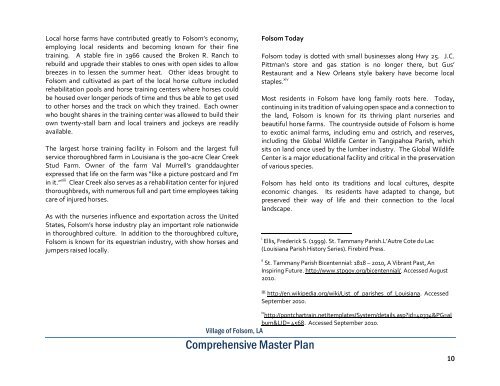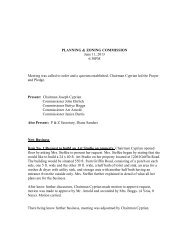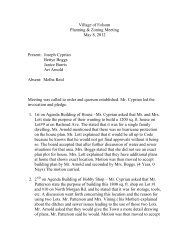Village of Folsom, LA
Village of Folsom, LA
Village of Folsom, LA
Create successful ePaper yourself
Turn your PDF publications into a flip-book with our unique Google optimized e-Paper software.
Local horse farms have contributed greatly to <strong>Folsom</strong>’s economy,<br />
employing local residents and becoming known for their fine<br />
training. A stable fire in 1966 caused the Broken R. Ranch to<br />
rebuild and upgrade their stables to ones with open sides to allow<br />
breezes in to lessen the summer heat. Other ideas brought to<br />
<strong>Folsom</strong> and cultivated as part <strong>of</strong> the local horse culture included<br />
rehabilitation pools and horse training centers where horses could<br />
be housed over longer periods <strong>of</strong> time and thus be able to get used<br />
to other horses and the track on which they trained. Each owner<br />
who bought shares in the training center was allowed to build their<br />
own twenty-stall barn and local trainers and jockeys are readily<br />
available.<br />
The largest horse training facility in <strong>Folsom</strong> and the largest full<br />
service thoroughbred farm in Louisiana is the 300-acre Clear Creek<br />
Stud Farm. Owner <strong>of</strong> the farm Val Murrell’s granddaughter<br />
expressed that life on the farm was “like a picture postcard and I’m<br />
in it.” xiii Clear Creek also serves as a rehabilitation center for injured<br />
thoroughbreds, with numerous full and part time employees taking<br />
care <strong>of</strong> injured horses.<br />
As with the nurseries influence and exportation across the United<br />
States, <strong>Folsom</strong>’s horse industry play an important role nationwide<br />
in thoroughbred culture. In addition to the thoroughbred culture,<br />
<strong>Folsom</strong> is known for its equestrian industry, with show horses and<br />
jumpers raised locally.<br />
<strong>Folsom</strong> Today<br />
<strong>Folsom</strong> today is dotted with small businesses along Hwy 25. J.C.<br />
Pittman’s store and gas station is no longer there, but Gus’<br />
Restaurant and a New Orleans style bakery have become local<br />
staples. xiv<br />
Most residents in <strong>Folsom</strong> have long family roots here. Today,<br />
continuing in its tradition <strong>of</strong> valuing open space and a connection to<br />
the land, <strong>Folsom</strong> is known for its thriving plant nurseries and<br />
beautiful horse farms. The countryside outside <strong>of</strong> <strong>Folsom</strong> is home<br />
to exotic animal farms, including emu and ostrich, and reserves,<br />
including the Global Wildlife Center in Tangipahoa Parish, which<br />
sits on land once used by the lumber industry. The Global Wildlife<br />
Center is a major educational facility and critical in the preservation<br />
<strong>of</strong> various species.<br />
<strong>Folsom</strong> has held onto its traditions and local cultures, despite<br />
economic changes. Its residents have adapted to change, but<br />
preserved their way <strong>of</strong> life and their connection to the local<br />
landscape.<br />
i Ellis, Frederick S. (1999). St. Tammany Parish.L’Autre Cote du Lac<br />
(Louisiana Parish History Series). Firebird Press.<br />
ii St. Tammany Parish Bicentennial: 1818 – 2010, A Vibrant Past, An<br />
Inspiring Future. http://www.stpgov.org/bicentennial/. Accessed August<br />
2010.<br />
<strong>Village</strong> <strong>of</strong> <strong>Folsom</strong>, <strong>LA</strong><br />
Comprehensive Master Plan<br />
iii http://en.wikipedia.org/wiki/List_<strong>of</strong>_parishes_<strong>of</strong>_Louisiana. Accessed<br />
September 2010.<br />
iv http://pontchartrain.net/templates/System/details.aspid=40334&PG=al<br />
bum&LID= 4568. Accessed September 2010.<br />
10




